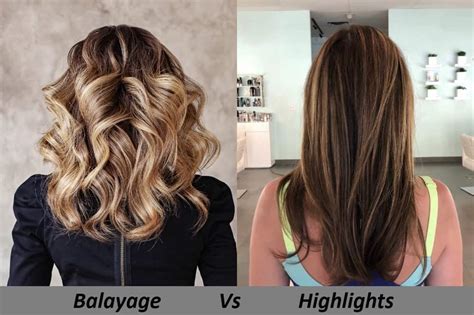Introduction (Use tag)

Hair coloring techniques have evolved over the years, offering endless possibilities to enhance your look. Two popular choices that stand out are balayage and highlights. Deciding which one is right for you can be a challenge, but understanding their key differences will help you make an informed decision.
What is Balayage?
Balayage is a freehand hair painting technique that involves hand-painting highlights onto sections of hair, creating a natural-looking, sun-kissed effect. The term “balayage” comes from the French word “balayer,” meaning “to sweep.”
What are Highlights?
Highlights, also known as traditional highlights, are created using foil or a cap to separate and lift the color of selected strands of hair. This technique results in more defined and contrasting strands, adding brightness and dimension to your hair.
Key Differences
To help you visualize the differences, here’s a concise table:
| Feature | Balayage | Highlights |
|---|---|---|
| Technique | Freehand painting | Foil or cap separation |
| Placement | Random sections | Selected strands |
| Color Blending | Seamless transition | Defined contrast |
| Maintenance | Touch-ups every 3-6 months | Regular touch-ups every 4-8 weeks |
Benefits of Balayage
- Natural-looking: Balayage creates a subtle, sun-kissed effect that blends seamlessly with your natural hair color.
- Low maintenance: With fewer lifted strands and a gradual transition, balayage requires less frequent touch-ups.
- Versatile: Balayage can be customized to suit any hair length, texture, and skin tone.
- Protective: The freehand technique minimizes damage to the hair, as it doesn’t require bleach to be applied to the entire head.
Benefits of Highlights
- Versatile: Highlights can be tailored to create a variety of effects, from subtle to dramatic.
- Instant brightness: By lifting strands of hair, highlights instantly add brightness and dimension.
- Long-lasting: Highlights are more permanent than balayage and require less frequent touch-ups.
- Corrective: Highlights can be used to blend away gray hair or enhance existing highlights.
Which Technique is Right for You?
Choosing between balayage and highlights depends on your personal preferences and hair goals. Consider the following factors:
- Natural vs. Dramatic Look: If you prefer a seamless, sun-kissed look, balayage is your best choice. If you want more defined and contrasting strands, highlights are the way to go.
- Maintenance Level: Balayage requires less maintenance and touch-ups compared to highlights.
- Hair Type: Balayage works well on all hair types, including thin, thick, or curly hair. Highlights are more suitable for thicker hair that can withstand the color processing.
- Hair Length: Balayage is an excellent option for longer hair lengths, as it creates a natural transition and movement. Highlights can be used on shorter hair to add subtle or more dramatic effects.
Tips for Balayage and Highlights
- Consult a Professional: Always seek the advice of a professional hairstylist to determine the best technique and color for your hair.
- Start Gradually: If you’re new to hair coloring, start with a few subtle highlights or a balayage to gradually change your look.
- Protect Your Hair: Use color-protecting shampoos and conditioners to maintain the vibrancy of your color and minimize fading.
- Avoid Over-Processing: Too much bleaching can damage your hair. Discuss with your stylist how to minimize damage while achieving your desired color.
Common Mistakes to Avoid
- DIY Disaster: Attempting these techniques at home can lead to uneven results or hair damage.
- Over-lighting: Too much lightening can weaken your hair and cause breakage.
- Wrong Color: Choosing a shade that doesn’t complement your skin tone or natural hair color can create an unflattering effect.
- Inconsistency: Failing to maintain your color consistently can result in uneven fading or hair damage.
Conclusion
Both balayage and highlights are excellent hair coloring techniques that can enhance your appearance. Understanding their unique benefits, maintenance requirements, and which technique suits your specific needs is crucial for achieving the look you desire. With the right choices and professional expertise, you can transform your hair and boost your confidence.
